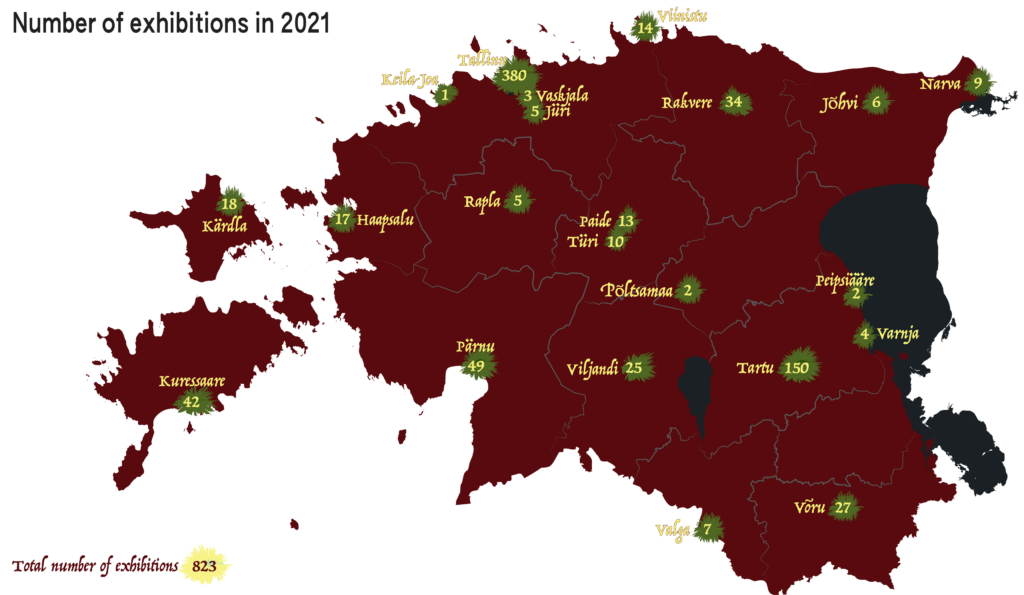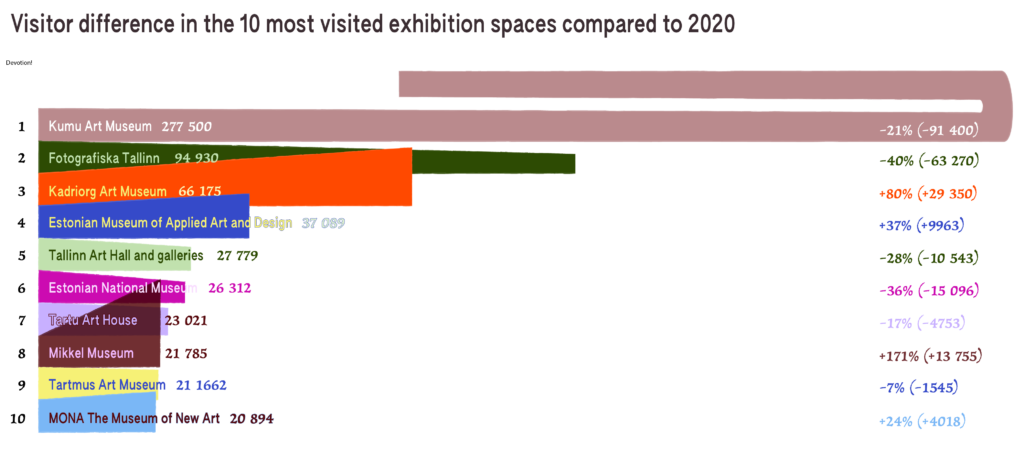Exhibition statistics in Estonia in 2021
In 2021, art exhibitions were held all over Estonia: all together in 22 cities, towns or villages. Statistics include information from 95 exhibition institutions located in Tallinn, Tartu, Pärnu, Haapsalu, Jõhvi, Jüri, Kärdla, Kuressaare, Narva, Paide, Põltsamaa, Rakvere, Rapla, Türi, Valga, Vaskjala, Viinistu, Viljandi, Varnja and Võru.
In 2021, a total of 823 art exhibitions took place, which indicates an increase compared to 2020 (807 exhibitions). About half of these took place in Tallinn (380 exhibitions, 51 exhibition houses), followed by Tartu (150 exhibitions, 12 exhibition houses) and Pärnu with 49 exhibitions (4 exhibition houses). In the 2021, out of the 823 exhibitions at least 167 included artists or curators based outside Estonia.

In the 2021 statistics, the 2020 COVID-19 pandemic is still visible, as it left a considerable mark in the visitor numbers of art exhibitions. In the second year of the pandemic, the visitor numbers were even lower, dropping to 931 831 visits, which is 97 052 visits less than in 2020 and even 989 584 visits less than in 2019 . Compared to 2020, among the most visited exhibition institutions, the number of visits dropped as follows: 21% at Kumu Art Museum (-91 400 visits), 40% at Fotografiska (-63 270 visits), 28% at Tallinn Art Hall and its galleries (-10 543 visits), 36% at Estonian National Museum (-15 096 visits), 17% at Tartu Art House (-4753 visits) and 7% at Tartmus (-1545 visits). Compared to the previous year, in 2021, the number of visits increased significantly at Mikkel Museum and at Kadriorg Art Museum, respectively 171% (+13 755 visits) and 80% (+29 350 visits). The number of visits also increased at the Estonian Museum of Applied Art and Design (37%, +9963 visits) and at the Museum of New Art (24%, +4018 visits).

The most visited exhibitions still include the permanent expositions of larger exhibition houses, most likely due to the fact that these are open throughout the year. The top three most visited exhibitions include the permanent exhibitions at the Kumu Art Museum The Future is in One Hour: Estonian Art in the 1990s (52 000 visits in total), Conflicts and Adaptations. Estonian Art of the Soviet Era (1940–1991) (52 000 visits in total) and Landscapes of Identity: Estonian Art 1700–1945 (45 000 visits in total). Among changing exhibitions, in 2021 the most visited exhibitions included From Memling to Rubens: The Golden Age of Flanders at the Kadriorg Art Museum (30 500 visits) and two exhibitions at Kumu Art Museum: Up All Night: Looking Closely at Rave Culture (26 600 visits) and Art Is Design Is Art (23 600 visits). All together the ten most visited exhibition houses (596 253 visits) make up 64% of the total number of visits, which indicates a 12% decrease in comparison to 2020.

In the 2020 and 2021 statistics, the data concerning language accessibility of exhibitions is highlighted. It shows that among the ten most visited exhibition spaces the ones that provide greatest language accessibility are still Tallinn Art Hall and its galleries and Tartmus. In both institutions, all exhibitions (20 and13, respectively) and the accompanying materials are provided in Estonian, English and Russian. Among other larger exhibition houses language accessibility has improved at Fotografiska, where 7 out of 10 exhibitions are fully accessible in Estonian, English and Russian. At Kadriorg Art Museum, the programme is accessible in Estonian, English and partly in Russian and in the case of one exhibition, in Dutch. Compared to 2020, language accessibility has remained the same at Kumu Art Museum, where 10 out of 12 exhibitions were still accessible in Estonian and English. At Estonian National Museum out of 13 exhibitions 5 were accessible in Estonian and English, 1 in Estonian, English and Russian and 7 only in Estonian. At the Estonian Museum of Applied Art and Design, Tartu Art House and Museum of New Art exhibitions are available only in Estonian and English. Kondas Centre, an institution that is not among the top visited spaces, is nevertheless notable due to the fact that their programme is available in Estonian, English, Finnish and Russian.
Numbers included in the statistics give a great overview of the total number of exhibitions in Estonia and their distribution by location. Visitor numbers, however, are to a degree subject to speculation. This is due to many exhibition institutions’ inability to count visitors. In larger exhibition spaces several exhibitions are open at the same time, however, they count the total number of visitors not the visitor numbers of each exhibition separately. As a result, we have presented exhibitions houses’ annual numbers as visits, not the total number of exhibition visitors.
The CCA has compiled data since 2016, when we started gathering and analysing exhibition related data from as many exhibition houses showcasing professional art as possible. Initially the aim was to map gender balance in the Estonian art scene. In the following years our data collection has expanded, now including number of exhibitions with participants form outside the country as well as visitor numbers. Statistical overview provides an important cultural political dimension to understanding local art field, providing data for analysing changes and developments occurring in the Estonian art field.